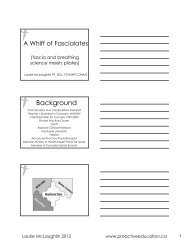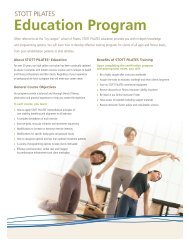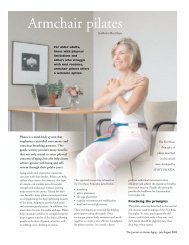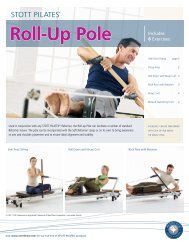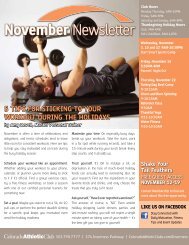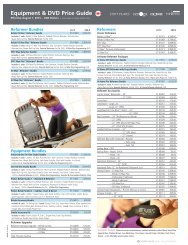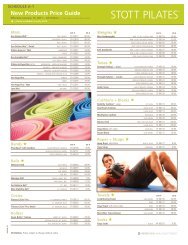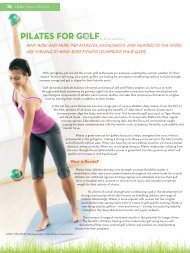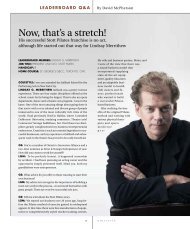CUEING FOR PILATES - Merrithew.com
CUEING FOR PILATES - Merrithew.com
CUEING FOR PILATES - Merrithew.com
Create successful ePaper yourself
Turn your PDF publications into a flip-book with our unique Google optimized e-Paper software.
32 OnSite Fitness | <strong>PILATES</strong><br />
Effective cues will also emphasize stabilization of the pelvis and<br />
lumbar spine both statically and dynamically in all positions and<br />
throughout all movements. Cueing pelvic stability during an<br />
exercise will ensure optimal performance of the movement and<br />
help prevent any unnecessary stress on the lumbar spine. The<br />
abdominal muscles must often be recruited to maintain the rib<br />
cage, and indirectly, the thoracic spine, in proper alignment.<br />
Instructors must cue participants to prevent the rib cage from<br />
lifting up in the supine position or deviate forward in a sitting<br />
position, causing the thoracic spine to extend.<br />
STOTT <strong>PILATES</strong>®<br />
photography ©<br />
<strong>Merrithew</strong> Corporation<br />
Instructors should remain aware of cueing stabilization of the<br />
scapulae and shoulders and realize the importance during the<br />
initiation of every exercise. When stability is absent, there is a<br />
tendency to overwork muscles around the neck and shoulders.<br />
Since they lack a direct bony attachment to the rib cage and<br />
spine, the scapulae have a great deal of mobility in making a<br />
greater range of motion available to the arms. Although the<br />
scapulae move with the arms, a sense of stability, not rigidity,<br />
should always be maintained.<br />
Regarding head and cervical spine placement, the cervical spine<br />
should hold its natural curve and the skull should balance directly<br />
above the shoulders when sitting in neutral. This position should<br />
also be maintained when lying on the back. In most instances, the<br />
cervical spine should be encouraged to continue the line created<br />
by the thoracic spine during flexion, extension, lateral flexion and<br />
rotation. Continually referring to these biomechanical principles<br />
will ensure that the cues an instructor is providing will help all<br />
clients or groups perform the exercises to the best of their ability.<br />
INEFFECTIVE CUES & UNDERSTANDING YOUR CLIENT<br />
According to research, one of the most overused cues in the<br />
Pilates industry at large is ‘slide your shoulders down.’ “While this<br />
may be effective with a small percentage of client groups, it can<br />
also have some very detrimental effects on others,” says Moira.<br />
“In many participants, sliding the shoulders down may overly




